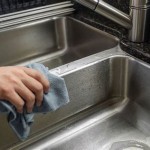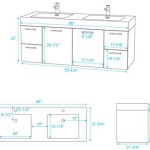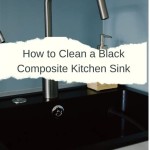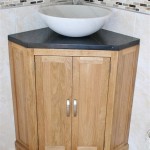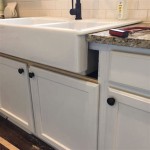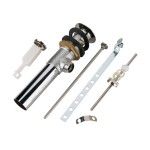Enameled Cast Iron Kitchen Sinks: A Comprehensive Guide
Enameled cast iron sinks have been a kitchen staple for generations, prized for their durability, classic aesthetic, and heat resistance. Their enduring popularity stems from a combination of practical functionality and timeless design, making them a worthwhile investment for any kitchen renovation or new build.
The manufacturing process involves pouring molten iron into a mold to create the sink's shape. After cooling, the sink is coated with a layer of enamel, a type of powdered glass, which is then fired at high temperatures. This fusion of iron and enamel creates a remarkably strong and resistant surface.
Durability and Longevity
One of the most significant advantages of enameled cast iron sinks is their exceptional durability. The enamel coating provides a hard, non-porous surface resistant to chipping, scratching, and staining. This resilience ensures the sink can withstand the rigors of daily kitchen use, including heavy pots and pans, sharp utensils, and acidic food spills. With proper care and maintenance, enameled cast iron sinks can last for decades, offering a long-term value proposition.
Classic Aesthetic and Design Versatility
Enameled cast iron sinks possess a classic appeal that complements a range of kitchen styles, from traditional farmhouse to contemporary minimalist. Their smooth, glossy surface adds a touch of elegance and sophistication to the workspace. Manufacturers offer a variety of colors, primarily white but also including shades of black, blue, and even red, allowing homeowners to personalize their kitchen design. Furthermore, these sinks are available in various configurations, including single and double basins, undermount, apron-front (farmhouse), and drop-in styles, offering flexibility for different kitchen layouts.
Heat and Sound Resistance
The inherent properties of cast iron contribute to the heat and sound-dampening qualities of these sinks. Unlike stainless steel sinks, which can resonate loudly when impacted by running water or dropped utensils, enameled cast iron sinks absorb sound vibrations, creating a quieter kitchen environment. Additionally, the material's heat resistance allows it to withstand high temperatures without warping or damage, making it safe to place hot pots and pans directly in the sink without fear of scorching or discoloration.
Maintenance and Care
Maintaining the beauty and longevity of an enameled cast iron sink requires relatively simple care. Regular cleaning with mild dish soap and water is typically sufficient. Abrasive cleaners and scouring pads should be avoided, as they can scratch the enamel surface. For stubborn stains, a gentle cleanser specifically designed for enameled surfaces is recommended. Promptly drying the sink after each use can help prevent water spots and mineral buildup. While the enamel coating is highly durable, it’s not entirely impervious to damage. Heavy impacts from dropped objects can potentially chip the enamel. If chipping occurs, touch-up kits are available to repair minor imperfections and prevent rust formation on the exposed cast iron.
Installation Considerations
Due to the weight of cast iron, professional installation is often recommended for enameled cast iron sinks. Reinforcing the cabinetry beneath the sink may be necessary to support the added weight. The installation process varies depending on the sink's style (undermount, drop-in, or apron-front) and the existing countertop material. Proper installation is crucial to ensure the sink is securely mounted and sealed to prevent leaks and damage to the surrounding cabinetry.
Cost Considerations of Enameled Cast Iron
Enameled cast iron sinks are typically more expensive than stainless steel sinks. This higher price point reflects the manufacturing process, the durability of the materials, and the classic aesthetic they offer. However, the long lifespan and timeless design of enameled cast iron sinks can make them a cost-effective investment in the long run, potentially outlasting multiple stainless steel sink replacements.
Comparing Enameled Cast Iron to Other Sink Materials
When considering a kitchen sink, comparing enameled cast iron to other common materials like stainless steel and composite granite is essential. Stainless steel offers affordability and ease of maintenance, but it can be prone to scratches and dents and may be noisier. Composite granite sinks are durable and offer a variety of color options, but they can be susceptible to chipping and staining from certain substances. Enameled cast iron strikes a balance between durability, aesthetics, and functionality, albeit at a higher price point.

Kohler Enameled Cast Iron Kitchen Sink Ph And Bathroom Blog Posts

Why Choose Cast Iron Sinks Ceco

How To Clean An Enameled Cast Iron Kitchen Sink The Inspired Hive

Why You Should Choose A Cast Iron Sink

Cast Iron Kitchen Sink Nh6008

Cast Iron Kitchen Sink Ci9603

Cast Iron Sinks Enameled Ceco

Ceco Doheny Enameled Cast Iron Undermount 50 Double Bowl Sink In Biscuit

Kohler Hartland Drop In Cast Iron 33 4 Hole Double Bowl Kitchen Sink Black K 5818 7 The Home

Kohler Whitehaven Farmhouse Apron Front 35 68 In X 21 56 Biscuit Cast Iron Double Offset Bowl Kitchen Sink 6427 96 At Com
